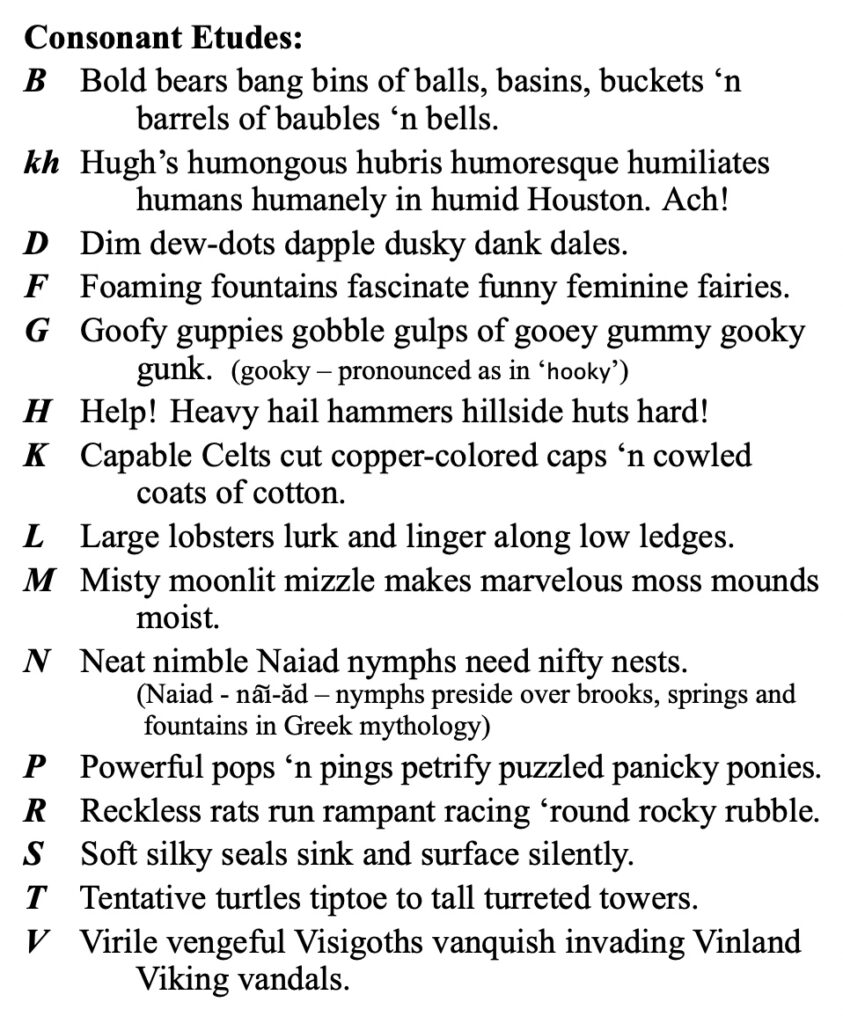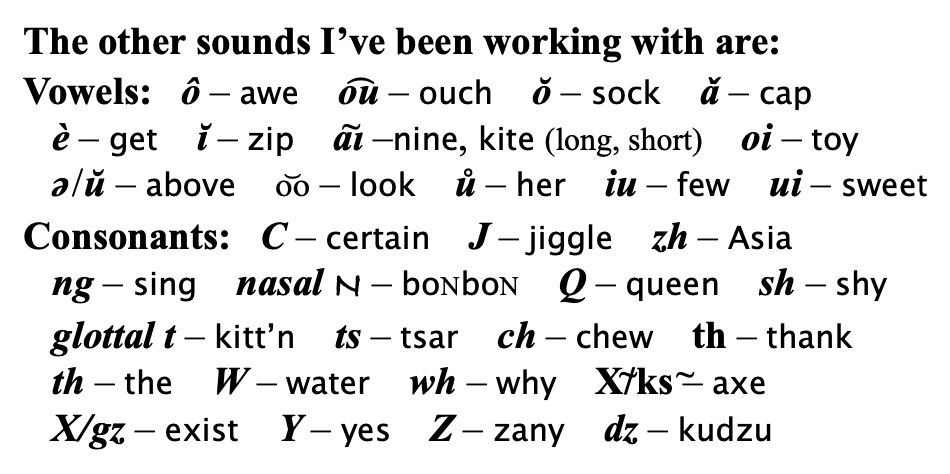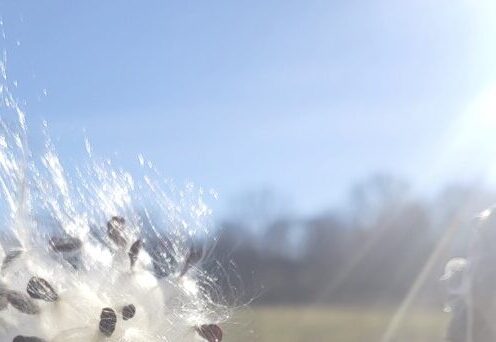
Revelations of the Word in the Arts of Speech, Poetry, Eurythmy, Music and Shakespeare’s Pentameter
Photo: Marc Clifton

WRITINGS
REVELATIONS OF THE WORD
Speech and Eurythmy as Visible Speech
Music and Eurythmy as Visible Singing
Shakespeare’s Pentameter
Support for the Work
References
Kate’s Publications (clickable list)
Keys and Short Documents (clickable list)
☆ NOTE: Full details on the sources of materials are given as much as possible. This is so that the reader is able to find them in the original context, to pursue their own study. I also give the original German texts at times (as on the Home page).
☆ NOTE regarding printing the downloadable materials: The blank pages found in the reports make the pagination come out right when they are printed double-sided. Keys and smaller documents often have a duplicate second page. This is to facilitate double-sided printing. (For landscape orientation, set the printer to short-edge flip or binding.)

SPEECH and EURYTHMY AS VISIBLE SPEECH
“The Sounds Themselves are Our Teachers”
The Speech Sound Etudes – a Report
Etudes for the Speech Sound B and a Collection
Many Fruits in Poetic Speech, Shakespeare and Eurythmy
A Sampling of Speech Sound Etudes by Kate
Two Keys: Markings for Speech Sounds and Poetic Rhythms
What is eurythmy?
Eurythmy is intended to be an objective gesture-expression of poetic speech and of melody, of music. Its intended objective expression is what differentiates it from other forms of movement or dance. On the About page is an article about it, which the reader may also read here:
EurythmyIs…,’17,KRH,092124,pdf
“The Sounds Themselves are Our Teachers” in Poetic Speech and in Eurythmy
“The sounds themselves are our teachers. It is only a matter of our knowing how to engage their help. If we have once understood this, then that will mean that all the several parts of our organism of throat and mouth have been received as pupils in the school of the sounds. The sounds are verily the gods from whom we are to learn how to form our speaking.”
… “In the sounds of speech live divine beings, and we must approach these beings with devotion, with prayerful devotion. They will then be the very best teachers we could possibly have. … For in these divine teachers of ours, in these sounds of speech, a whole world is contained. If we would become true ‘formers of the word,’ we must never forget that the word was ‘in the beginning.’”
– Rudolf Steiner, Speech and Drama, Lecture 18 (about 1/5 in, and a bit more than halfway in).
Seeking a Verifiable Foundation for the Gestures of Eurythmy as Visible Speech BEGINS WITH SPEECH!
Without being conscious of what Rudolf Steiner had said about the sounds themselves teaching our speech organs what to do, in late 2012 I read that he had instructed the first eurythmist to write sentences that sound only one vowel repeatedly and to do “speech exercises” with these, and also to work with alliteration – the repetition of consonants in lines of verse (see the example of alliterations I have composed for B in the right column here). I sensed that these writing and speaking tasks were the keys that I needed for the work of securing a verifiable foundation for the gesture-expression of speech in eurythmy movement.
And in fact these sentences proved to open the door into poetic speech-work and into eurythmy gesture-expression. I composed and spoke reams of them; and I called them ‘études’ (French for ‘study’ – études such as are composed for music practice). I discovered that repeatedly speaking such sentences evokes the inner movement-impulse of each sound, a distinct impulse which is largely muted by our overt speech activity. With sufficient sensitivity and attention, I became increasingly aware of these impulses and could differentiate their qualities. With devotion, quietly and without imposing myself on them, when the impulses were clear enough, I could allow them to come forth as gesture, bodily gesture.
I recount this intense and quiet process in several of my writings, the first of which was the report, The Speech Sound Etudes: Feeling the Gestures and Finding the Figures, originally posted at Michaelmas, September 29, 2014. The ‘Figures’ are drawings made by Rudolf Steiner that depict the gesture-dynamics of five vowels and fifteen consonants. In this report I share how I prepared for this successful work – such that when I finally looked at the Figure drawings after having laid them aside for years, I found that Rudolf Steiner corroborated many of my findings concerning these gestures! (For more about the preparatory tasks, see the Support for the Work section here below).
Here is the report:
SpeechSoundEtudesReport,102624,KRH,pdf (20 pages)
(Note: if you hover over the Contents entries of the report, you will find they are clickable, to go to those sections.)
My article, “Imitation and Mental Imagery in Eurythmy: a Century-Long Detour” discusses the history that led to reliance in eurythmy on the imitation and gesture-formulas that have been passed down for decades, and then describes this process that I work with, of being taught by the sounds themselves. I am not alone in earnestly wanting this direct path to the gestures: in 1999, a group of forty-five third-year eurythmy students attending eurythmy programs in Europe issued a plea, that please, may this teaching by imitation stop. The article, “Eurythmy as a Critical Art: What This Means for its Future,” includes an excerpt from their “Open Letter – to All Eurythmy Trainings.”
The two articles:
Imitation,Imagery,Detour,’22,KRH,110224,pdf and
EurythmyAsCriticalArt,’16,KRH,100524,pdf

Etudes for the Speech Sound B:
Boiling buckbean bubbles billow ‘n burst!
Bulls buck, bothered by bunches of busy buoyant bouncing bullfrogs.
Bold bears bang bins of balls, basins, buckets ‘n barrels of baubles ‘n bells.
Burly butchers beat back bombastic bullies with boomerangs ‘n barbed bayonets in barren boulevard battlefields. Boom!
(Also see “Beginning With B in Light of Goethe’s Sensible-Supersensible Process.”
BeginningB,Goethe’sProcess,’17,KRH,091624,pdf)
A Collection of Etudes by Kate:
The Speech Sound Etudes, Volume I: Revelations of the Logos – Poetic Miniatures for Sounding our Language
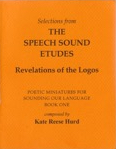
This collection of etudes by Kate presents a set of etudes for each sound that gives a sense of the scope of that sound’s activity. These etudes are many of the ones that have proved themselves to be the most helpful in evoking the gestures. There is the full manual (the original) and a Slim Edition. Contact Kate or inquire at the Rudolf Steiner Library in Hudson NY or the Turose Gift Shop in Ghent NY.
(See a sampling of the vowel and consonant etudes further along here below.)
◇ ◇ ◇
First Fruits: Poetic Speech!
Working with the speech sound etude-studies so intensively led me to a new ability to work with poems. What Rudolf Steiner said about the sounds themselves teaching the speech organs what to do is absolutely true!
It now became possible for me to perceive the detailed soundscape and detect the sound-mood (or moods) of each piece and to express these through the poem itself. And in the presentation of poems, I found that these moods can be evoked before and after the poem, as a prelude and postlude composed of three or four specially-chosen or written etudes (this is much like the silent movement before and after poems in eurythmy presentations). The article, “Etheric Bodies are Moving to the Speech Sound Etudes” describes how I approach poems this way. It focusses on Edna St. Vincent Millay’s, “Conscientious Objector,” and Matthew Arnold’s, “Dover Beach.”
EthericBodiesMoving,’16,KRH,091624,pdf
For this work with poems in speaking, and also for eurythmy, I began to develop ways to mark the texts to indicate the sounds and rhythms. In English, letters can often stand for more than one sound!. See below for the two keys of the speech sound markings that i now use.
Fruits in Eurythmy-Expression!
As Rudolf Steiner had said in his News-Sheet report on his lecture cycle, Eurythmy as Visible Speech, that the eurythmist “must, before all, have approached the mysteries of speech creation” (see the panel on the Home page here). In his lectures on therapeutic or curative eurythmy (GA 315), he spoke about what the larynx is doing on a higher level – not the physical larynx, but the etheric larynx. To supersensible perception, our etheric larynx is seen to be gesturing, making movements which stir our entire etheric body, the body of life forces. One can begin to sense these non-physical movements when reciting the speech sound etudes, as my work has revealed.
Further Fruits in Poetic Speech:
Shakespeare’s Blank Verse Pentameter!
Working with the speech sound etude-studies so intensively – composing them, speaking and honing them in order to bear witness to the stirring of the gesture-impulses of eurythmy ‘from within’ and bring them forth – made me more and more sensitive to the dance of the word-rhythms and the distinct way in which the words of a sentence flow from start to finish – also as regards the nature of the parts of speech, nouns, adjective, verbs, etc.! The quality of the breath that is involved in each etude also became apparent and grew more finely-tuned according to each one’s need without any great effort on my part to regulate it. These developments in my speaking led me to be able to work with Shakespeare’s pentameter in such a way that I overcame the impasse I had felt regarding how the five iambic feet relate to each other and how each line needs to move. My report, Revealing the Music of Pentameter: Putting Shakespeare Through His Paces, recounts my path and what I found (also see the full section on Shakespeare’s Pentameter here below). Pentameter,Shakespeare’sPaces,Report,102624,KRH,pdf
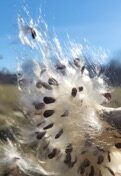
◇ ◇ ◇

A Sampling of Speech Sound Etudes by Kate for Each Sound (in English)
Here are the examples that I shared in The Speech Sound Etudes report. Also see the set of etudes for B (here above).
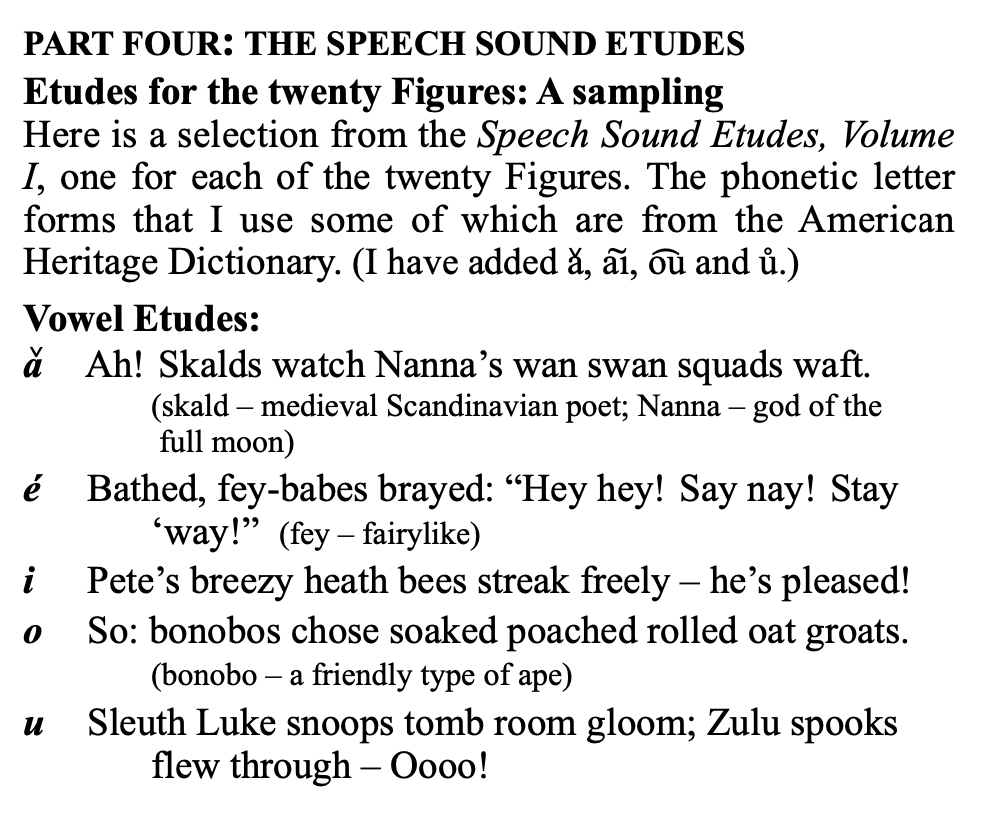
☆ I want to encourage readers to compose and speak their own etudes. I have found that repeatedly sounding the vowels and consonants in the context of the flow of language itself like this helps the sounds to be very powerful teachers!
◇ ◇ ◇

Two KEYS for Marking Speech Sounds and Poetic Rhythms, Developed by Kate
1. Short Version
Here are the markings that I use for poetic texts, as presented on page 27 in the report, Revealing the Music of Pentameter:
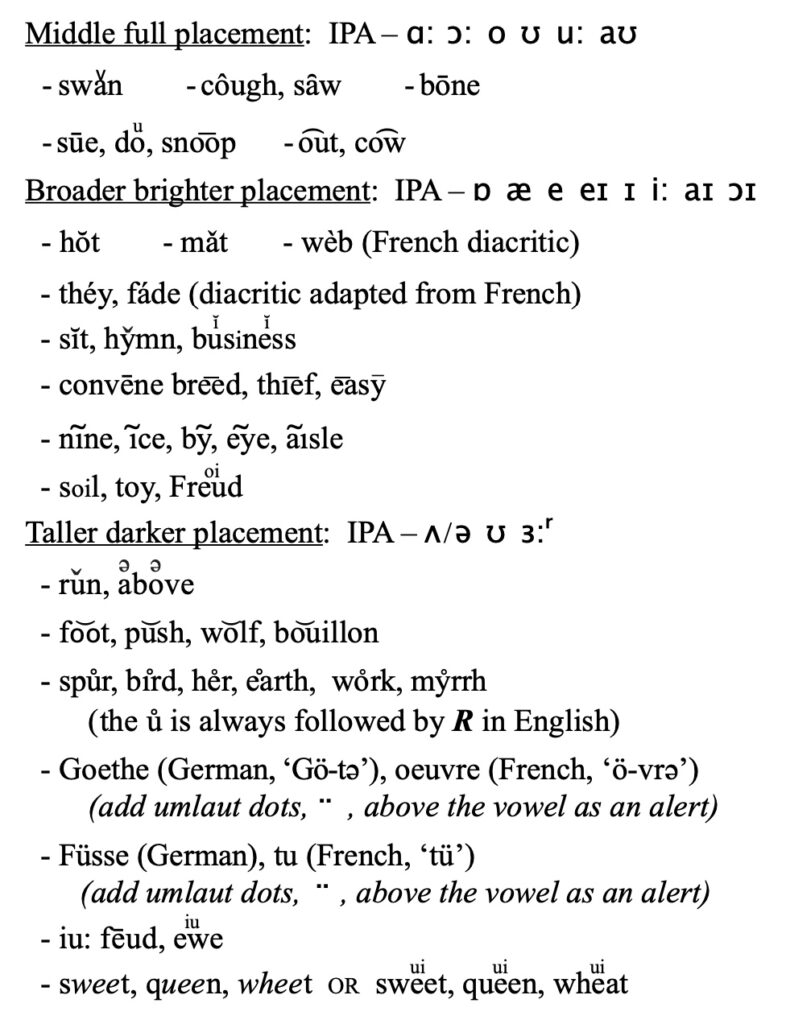
2. The FULL Key to Speech Sound and Rhythmic Markings
This full array of markings for poetic texts is the result of the work that culminated in the collection, The Speech Sound Etudes: Revelations of the Logos, Volume I (the manual version).
This key has four extensive panels with many word examples. The English language has incorporated quite a range of soundings that need to be taken into account. And different accents in English will likely give rise to different or differently-nuanced speech sound gesture-impulses. For instance I have heard an Irish writer speaking in English, whose T was formed in the back of the mouth! – a much different sound. I call it the ‘glottal T.’ We do make this sound, too, but not as strikingly as in this writer’s speech.
SpeechSoundMarkings,091424,KRH,pdf

◇ ◇ ◇ ◇ ◇

MUSIC and EURYTHMY AS VISIBLE SINGING
Tonal Music: It is All About Relationships
Solfège in the Service of Tonal Experiences – Movable Do
Key to a Fully-Chromatic Numerical Solfège
The Agrippa von Nettesheim Positions
“The Case for Movable Do” by Michael Kaulkin
And Medieval Singers Knew, Too
Singing and Jumping Opens the Way – a Report
The Relationships Within the Circle of Fifths of Tonal Music
Harmonic Markings Chart
MUSIC – and in Particular
Tonal Music
What is it that makes our Western music tonal? What is ‘tonal’?
In music studies, I learned music theory; for in our time – as in other periods in the development of music – musicians have made efforts to elucidate their practice. Being mathematically-agile, I was adept at analyzing pieces of music for their key* and for their harmonic movements. Nevertheless, I felt unable to get to the heart of what really moves in the music that I was playing on piano and singing in the chamber group and chorus. My innate musicality seemed to be the limit of what I could bring to my expression. *(Note: each notated key signature can signify two different tonal keys.)
Discovering the ‘Gebilde’
It was only when I began the four-year program in eurythmy-movement that a door began to open at this foundational level in music. Rudolf Steiner had said near the opening of Lecture 1 of his 1924 cycle on Eurythmy as Visible Singing, that the onlooker of the eurythmy-expression “actually perceives what the eurythmist feels and inwardly experiences.”* And he explained that the experience that the eurythmist must have and convey to the onlooker is that of the ‘Gebilde’ of the music. He said that this is the case in speech eurythmy, too, in which the ‘Gebilde’ of the poetry is to be conveyed. *(The full quote in English and in German is on the Home page here.)
This German word, ‘Gebilde,’ stems from the verb, ‘bilden.’ It points to that which has been built up, constructed, formed, fashioned, arranged, etc. In other words, the Gebilde is the formative-structuring of the music and of the poetic speech. This lawful, formative-structuring is brought about through the creativity of the WORD working in our music-making and poetry-creation, though Rudolf Steiner did not in that moment speak of the WORD.

Tonal Music is All About Relationships
Discovering the ‘tonic’ in our music
In each piece of tonal music, the foundation of this formative-structuring is the ‘tonic.’ Everything centers on it. Have you seen the film, The Sound of Music, by Rodgers and Hammerstein? If so, you will have heard the “Do-Re-Mi Song.” This song introduces the musical scale as a tonal reality – meaning that all of the scale members support ‘do’ as the ‘tonic,’ the home center of the melody. The members are: ‘do re mi fa sol la ti’ and ‘octave do.’ This ‘do’ or tonic‘ – or ‘prime’ – is where melodies often begin and journey forth and to which they return. For example, the round, “Row, Row, Row Your boat,” begins and ends with ‘do.’ The carol, “Joy to the World,” descends the scale from octave-‘do’ to prime-‘do.’ “Happy Birthday” does not begin with ‘do,’ but ends resoundingly with it.
There is a great deal more to the phenomenon of tonal-ity than what is evident in a simple melody; but this fact of the ‘tonic’ is the foundation of tonal music as it manifests in each piece: one pitch-tone serves to manifest this inaudible phenomenon of tonic-ness; and the other pitch-tones serve in roles that support this tonic, each having a specific relationship to it. And this tonic in return plays its role as the tonic.
The tensions and relaxations in the melody arise from this formative scale-structure, and so do the harmonies. The dynamics of this structure also govern how a melody will ‘modulate’ by causing the scale members to require a different pitch-tone to serve as ‘do,’ as the tonic of the melody.
The formative-structure is the music, not the particular named pitch-tones that happen to serve in the tonal roles and relationships.
Although the experience of these roles – and especially of the dynamic difference between the two sets of four members known as the lower and upper tetrachords (steps 1 2 3 4, and 5 6 7 8) – was not explored in my years of music study, eurythmy holds a huge potential for cultivating these experiences extensively, if it is taken up as Rudolf Steiner appears to have intended in relation to music. And taking up what he pointed to beginning in 1915 is what my writings on music eurythmy are about – my articles and my four-part report, Singing and Jumping Opens the Way to a Vital Music Eurythmy Foundation (pdf links are below).
◇ ◇ ◇
SOLFÈGE in the Service of a Deep Experience of Tonal Music: Movable-Do
in the film version of her life, The Sound of Music (Rodgers and Hammerstein), Maria von Trapp was so right to begin her work of making the seven children into a chorus by introducing them (and us) to solfège – the ‘do re mi’ of music. I find nothing better! And my improvement to the centuries-long practice of using solfège syllables (since the Middle Ages) has been to develop a fully-chromatic numerical solfège. Using numbers rather than the standard syllables instantly corresponds to how music theory uses numbers to elucidate musical relationships. It does not matter at all which named pitch serves as ‘do,’ as the tonic-prime, as number 1. All that matters is that it is experienced as ‘do.’
If the melody announces a different tonic, the set of numerical solfège syllables, 1 through 8, then move, since ‘1’ is always applied to whichever pitch-tone serves as the tonic-prime. The solfège always makes clear the formative tonal scale-structure as experienced in the moment; hence is it is movable-do solfège.
Key to the Fully-Chromatic Numerical Solfège:
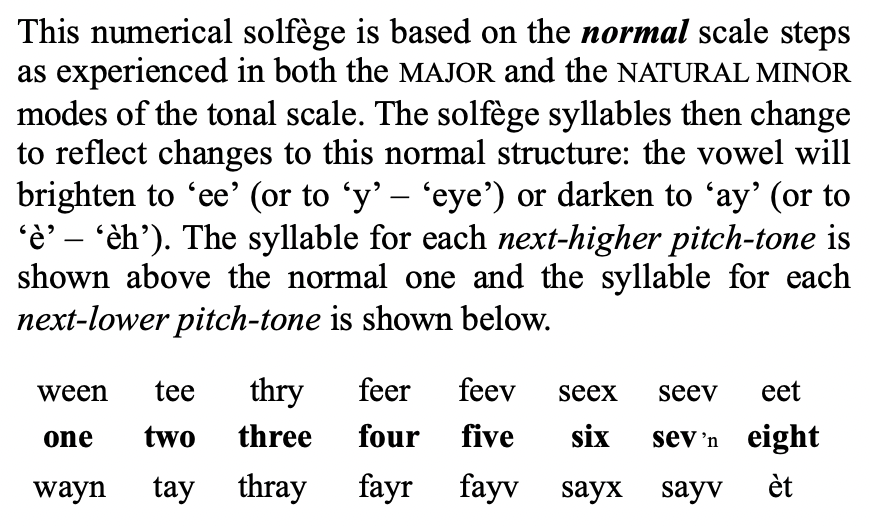
NumericalSolfège,FullyChromatic,KRH,092924,pdf
Articles That Unfold the Spirit of the Tonal Scale Through Movable Do in Singing and in Eurythmy Expression
“The Scale Degree Intervals Give Rise to Our Tonal Music Gebilde” ScaleDegreeIntervals,TonalGebilde,’19,KRH,100924,pdf
“Fixed Do and Movable Do in Our Eurythmy: Does It Matter?” (this website version is enlarged from the Eurythmy Association of North America Newsletter, EANA version). Modulation within the laws of the Circle of Fifths as the revelation of tonal relationships is elucidated here and hopefully demystified!
FixedvsMovableDo,Matters,’21,KRH,101824,pdf
This article grew into the first half of PART III of the Singing and Jumping Opens the Way report (see below).
“The Agrippa von Nettesheim Positions: Rudolf Steiner Told Lory to Jump!” I find that not only does jumping these positions in sequence engender a sense for living, developmental processes: it also corresponds to the tonal scale and substantiates the nature of the angle-gestures which Rudolf Steiner presented in 1915, in expression of the tonal scale in its major mode and minor mode.
AgrippaJump!,’20,KRH,092524,pdf
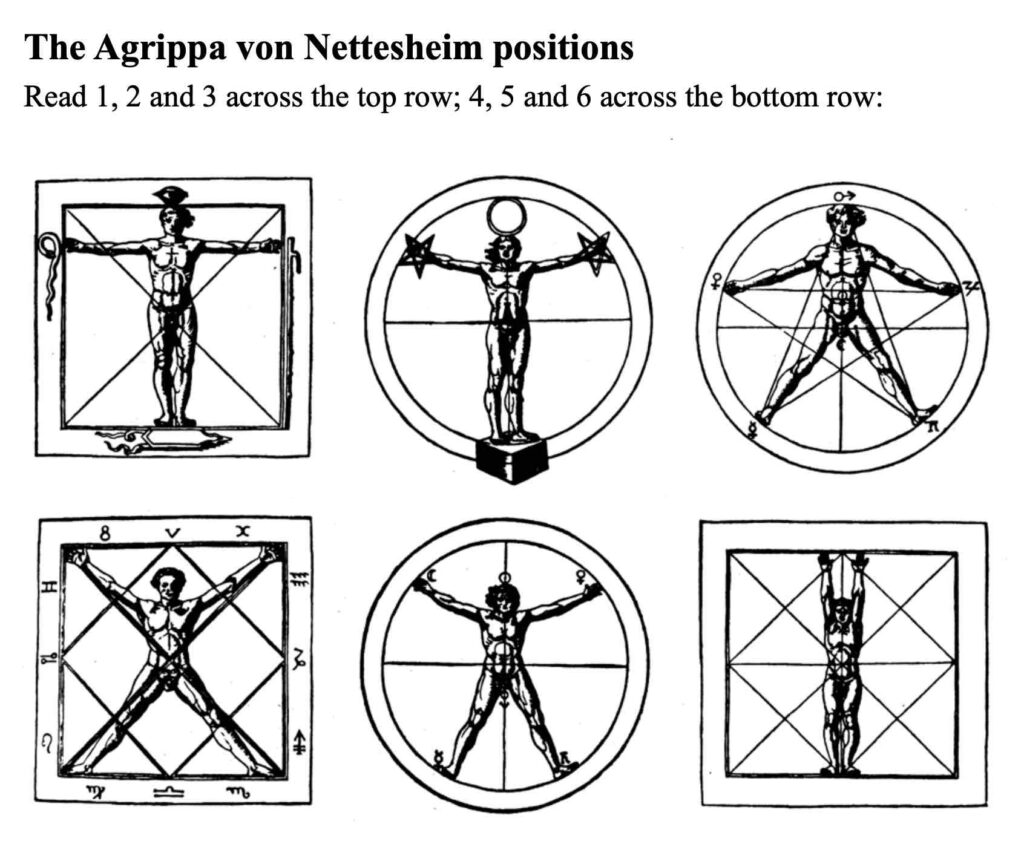
Part IV of the report, Singing and Jumping Opens the Way (see below), presents exercises to further our experience of the steps of the tonal scale. We will find that the scale-step intervals and the melodic intervals are the same inner experience. I have found that the difference between them is that the scale-step intervals are structural – living between the scale-step members as interval relationships that endure, unaffected by the time element (the structure only changing when the tonal center changes) – whereas the melodic intervals unfold in time.
“The Case for Movable Do” by Michael Kaulkin
The Practice of Movable Do in music – and in eurythmy – opens us to the world of tonal musical relationships and modulation. Fixed Do does not.
Michael Kaulkin, composer, teacher and choral director, corroborates the exceptional value of movable-do solfège. Here is from his article, “The Case for Movable Do in Classroom Musicianship”:
“The Movable Do system emphasizes each note’s function in the given key. In the major Do is always scale degree 1, So [sol] is always scale degree 5, etc., no matter what the key. Here what’s important is knowing what each note’s role is in whatever key you’re in. People with perfect pitch have a hard time with this”. …
“The Fixed Do system is nothing other than what’s used in certain European countries* as an equivalent to our letter names [for pitch-tones]. Over time, using it may teach students by rote how to sing the notes, but [fixed do] will not teach them intervals. It will not teach them anything about harmony or function, to say nothing of voice leading [i.e., voices taking turns with a motif or a fugue theme] …”
“The mistake being made here is to think that [movable do] would ever be a quick or easy process. It is in fact a very slow-moving process whose purpose is to bring about deep understanding of the musical processes that drive the music we’re learning to sight read. It is not meant to be a quick way to get your chorus to learn their material.”**
Michael Kaulkin indicated that it could take three years for a group to gain fluency in movable-do solfège. And why would this be? With movable do we are getting away from the encoding of pitches. We are entering into the real ‘Gebilde’ of the music, into its inaudible, archetypal realities, its formative-structuring.
He wrote (italics added): “Yes, you have to decide where the do change occurs [during key changes] and there isn’t always one right answer, but with practice you become adept at analyzing music on the fly and you always know where you are within the big picture.”
I agree! And I have found that the movable-do solfège awakens in us exactly the musical experiences that are to be brought to expression through eurythmy. One can discover that singing the in-the-moment scale-steps this way also evokes perception of the melodic intervals between them. I want to add that one can perceive it in concert when performers experience these supersensible formative tonal phenomena! Then what is heard far transcends the audible, which is only the vehicle for the actual music. This is the goal.
*(Countries such as Belgium, Brazil, Spain, Portugal, France, Italy, Germany, Romania, as well as Latin America, French-speaking Canada, Russia, Ukraine, Bulgaria and Israel.)
**(A professional eurythmy program is typically full time for four years – ample opportunity for students to achieve this fluency, and through it to achieve true competence with the formative Gebilde of tonal music.)
Kaulkin,091424,KRH,pdf
https://medium.com/@michaelkaulkin/the-case-for-movable-do-in-classroom-musicianship-6c06eb93c621
And Medieval Singers Knew, Too!
As mentioned by D.J. Grout in Chapter 2 of A History of Western Music, when chants or hymns were sung in the Medieval period, the start pitch would typically be higher in the morning and lower in the evening (p. 63). The singers understood notation as being purely relative, not fixed to pitches – i.e., they understood the movable nature of the formative structure of the music. The structure was also not tonal in the sense that our tonal music is: there was no sense of ‘ti,’ the 7th, reaching toward the octave.
◇ ◇ ◇
“… eurythmy is not something arbitrary … it is nothing other than the revelation of the experience.”
This is what Rudolf Steiner discussed about 4 pages into Lecture 2 of his cycle on Eurythmy as Visible Singing. It is exactly this that I have always wanted as the foundation of my work – that direct experience would permeate every part of my expression. Lectures 2 and 3 are phenomenal to study!
At the end of first year of eurythmy school, our teacher led us to the gestures which Rudolf Steiner had introduced in 1915 in expression of the tonal scale, beginning with the major mode. And because of how she did this, I had a wonderful experience of the rightness of these gestures in the form of angles made by the arms or the arms and legs with jumping. I found that these expressions are not arbitrary, but like the speech sound gestures, these tonal gesture-expressions come from the experiences themselves.
However, the nature of our practice changed abruptly at the beginning of second year; and this sense of rightness in expression of the tonal scale relationships was disrupted and lost. Each angle-gesture now signified an absolute pitch, as named and notated on the page. I no longer had a directly-experienced content for the gestures, as I did when they were revelations of the scale-relationships. This was a disaster for my feeling-perception of the tonal scale; and in my Part I memoir I describe the impact that this fixed system had on the pieces of tonal music we took up. With this change, I merely experienced my gesture-forming and the gesture sequences that I made with the angles, straight and bent, all signifying a specific note. Why nothing more than movement-production? For me, when hearing for instance the note we call ‘C-sharp,’ at no time did it evoke in me the gesture I was to do at that moment. And no coherent, non-theoretical explanation was ever given for this practice. My work is in large part in answer to the loss of the direct expression of the tonal relationships that can be actually experienced regardless of notation.
It was only recently with the publication of the earliest records that I learned that Rudolf Steiner had actually called the angle-gestures nothing other than “prime, second, third, fourth, fifth, sixth, seventh” and then “octave.” This is what was recorded by those who took notes. And then for the minor mode of the scale, the same gestures were made but much differently: earth-bound, sagging, and halting in the movement of the legs. And for minor, the scale he took as his example-scale for the minor was the one that begins with C-sharp! (Which example-scale he took for the major mode was not noted.) Clearly, this expression was not meant to convey the notes. And the angle-gesture for this note, C-sharp, was a straight angle, for it was the prime of the scale. Again he called the gestures, “prime, second, third” etc., just as for major, with no accommodation for the usual measurements of whole- and half-steps. To me, this was not at all some kind of naiveté on his part that would need to be fixed. The harmonic and melodic minor experiences are then expressed through a difference in feeling: “hard as icicles” for harmonic and “soft/yielding”(“weich”) for melodic. This makes feeling-sense to me.
Marie Steiner was also present. And about this sequence of gesture-expressions, she recorded: “The relationship of the second to the prime, the third to the prime, the fourth and so on” (in other words, and so on up the scale). Each member is in relationship to the prime. This points to the tonal scale* with its scale-step members.
*(Note: in what is recorded from Rudolf Steiner as lectures, I have only found references to the scale as singular, not as plural. Shortly into Lecture 1 of Eurythmy as Visible Singing in the German editions I have seen, Rudolf Steiner also spoke solely of “the scale” in the singular (and in these lectures, never the plural). I feel obliged to point out that the Anastasi 2013 version of the lectures in English shows “the scales” here. To my feeling, the Anastasi change to the plural disorients us for the entire discussion that follows in these lectures. I do not know whether this has been corrected in the January 2020 Anastasi edition.)
In my writings I am sharing what my experiences of music and music eurythmy have been and how I am finding my way into the eurythmy-expression of tonal music based on these earliest records. In the articles cited here above and in my four-part report, I am working to open up pathways of experience for us, along with trying to help us to understand the formative-structures we encounter in our tonal music. And for this I include explorations of a number of pieces.
Two further articles take up this early history – and also see more discussion of the earliest records in the Basics section of Singing and Jumping, Part I:
“The Earliest Records Show the Angle-Gestures as Movable Do” EarliestRecordsShowMovableDo,’22,KRH,100924,pdf
“My Responsibility to the Onlooker in Music Eurythmy” MyResponsibilityToOnlooker,’23,KRH,101924,pdf
Here is this same article in German: “Meine Verantwortung gegenüber Zushauenden in der Musikeurythmy”
MeineVerantwortung,Musikeurythmie,’24,KRH,101724,pdf
Singing and Jumping Opens the Way to a Vital Music Eurythmy Foundation – A Report on Music Eurythmy:
☆ Contents page for the entire Singing and Jumping report: Sing&Jump,Contents,081824,KRH,pdf
This not-yet-complete four-part report covers my experience of learning music eurythmy in the professional program, the nature of tonal music and its formative laws of movement, some discussion of the early history of music eurythmy-expression, and exercises to strengthen our experiences of tonal roles and relationships. (Note: the entries in the Contents list of the pdf for each part are clickable, to go to the sections. Part II is yet to come.)
“PART I, The Archetypal Scale and Its Disappearance” (first half, 36 pages). This is a memoir that also explores in tonal detail Bach’s BWV 367 Choral and a Sarabande by Jean Marie Leclair. Part I has a lengthy BASICS section which includes reference materials on tonal music and introduces the markings that I now use to indicate the tonal elements when preparing pieces. I,SingJump,1stHalf,Memoir,101824,KRH,pdf
Here are the accompanying scores for Part I:
I,Bach,Chorale367,071023,Plain,pdf
I,Bach,Chorale367,Annotated,091524,KRH,pdf
I,Leclair,Sarabande,070923,plain,pdf
I,Leclair,Sarabande,Annotated,091524,KRH,pdf
“PART III: Fixed Do and Movable Do in Our Eurythmy – Does it Matter?” (first half, 14 pages) includes discussions of two pieces, an Arioso by Bach and his Air on the G String. The scores for these pieces are in the document. (Note: the second half of this Part III will take up the history and development of eurythmy gesture-expression as it relates to the tonal scale.) III,SingJump,1stHalf,Fixed-MovableDo+Scores,101824,KRH,pdf
“PART IV: The Singing and Jumping Exercises – Real Sound-Experiences Lead to Real Gestures” (14 pages, complete). This presents exercises to awaken our sensibilities to the tonal scale and harmonic movements. These are the exercises that gave rise to the title of the report, Singing and Jumping Opens the Way. IV,SingJump,Exercises,103024,KRH,pdf
What About the Expression of Non-Tonal Music?
To my feeling, how non-tonal scales and music are to be expressed in eurythmy-gesture is a separate question to be pursued, as I know some eurythmists are doing. I believe that one would need to fathom what the actual experience of this music is, so that – just as for tonal music – the experience leads to and becomes the gesture. And the resulting gestures would not necessarily have any relation to the tonal gestures.

◇ ◇ ◇
The Relationships Within the Circle of Fifths of Tonal Music
(Click the pdf link open to see a larger image):
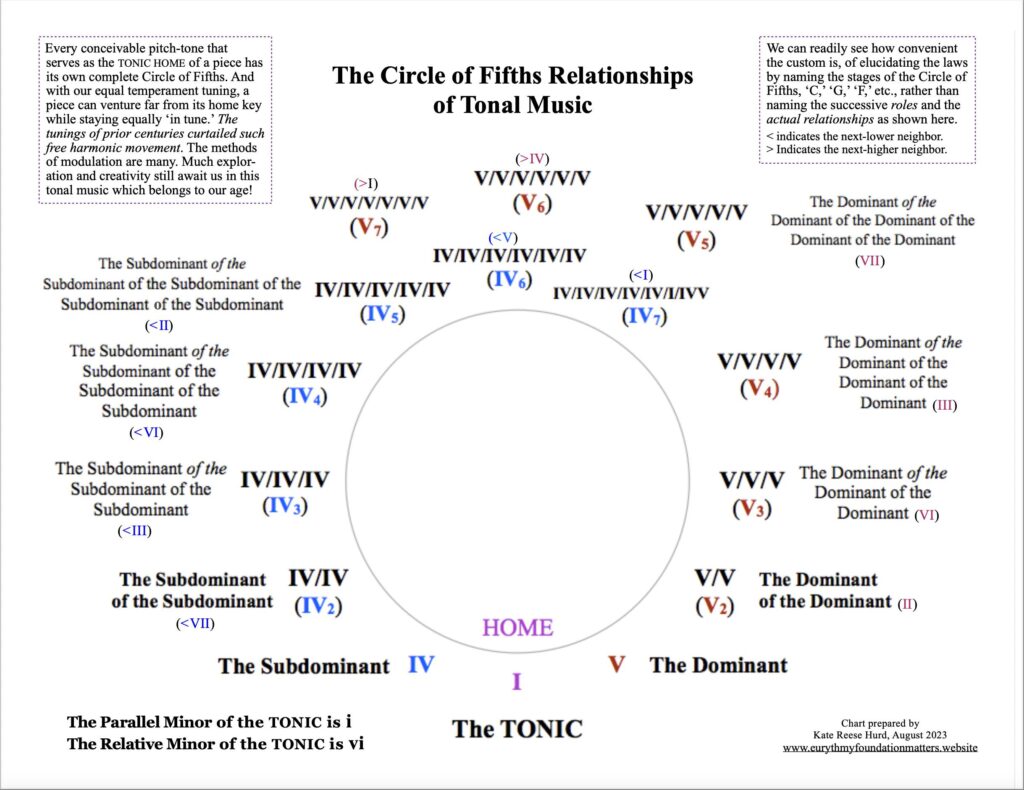
Harmonic Markings for Pieces of Music
As introduced in Part I of Singing and Jumping Opens the Way (see the BASICS section of the report), here are some new and revised methods for making note of the tonal journey of pieces in preparation for eurythmy expression:
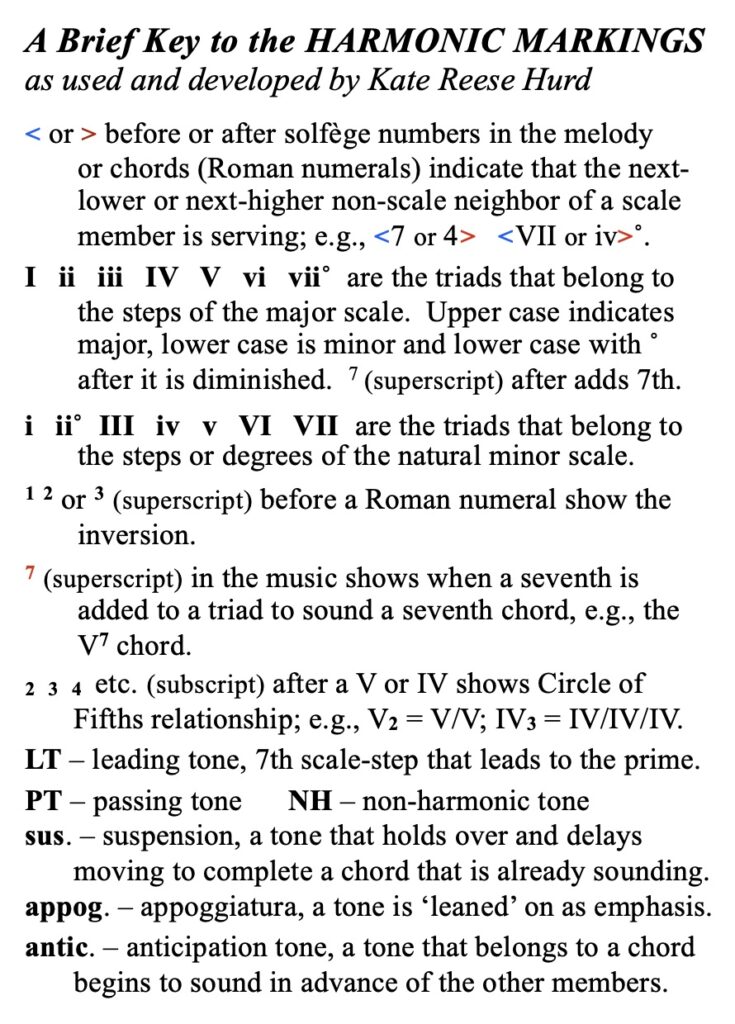
To see both pages of the harmonic key:
HarmonicMarkings,091424,KRH,pdf
◇ ◇ ◇ ◇ ◇

SHAKESPEARE’S PENTAMETER
The Sense of Missing Something
The Formative Musicality of Pentameter
Revealing the Music of Pentameter … Shakespeare’s Paces – a Report
We Can Conduct Our Speaking to Rehearse the Blank Verse
The Deeper Rhythmic Reality of the 4-Beat Structure
Goethe Rehearsed his Verse Dramas Using a Baton
Plumbing the Depths of Sound-Creation
The Actor’s Two Tasks
The Chronic Sense of Missing Something in Shakespeare’s Blank Verse
Beloved Director John Barton of the Royal Shakespeare Company expressed a sense of failure when discussing Shakespeare’s blank verse with the Company:
“And I suppose I feel a particular sense of failure when I talk about Shakespeare’s poetry. It’s a problem that’s haunted me over the years, and which I’ve never really solved. When I read a Shakespeare text, I’m moved and stirred by the power and the resonance of individual lines. … Yet nothing I’ve said so far about marrying our two traditions, Elizabethans and moderns, necessarily helps to bring about what I can both hear and can feel in the lines as I read them. … Yet I feel I’m missing something and in rehearsal I often don’t know what to say or how to help the actor.” (See the ninth of nine programs, RSC Playing Shakespeare, 1984, “Poetry & Hidden Poetry,” 3 minutes in. You might have to hunt on the internet to find the YouTube films of the programs. My link for viewing all nine stopped working.)
The richness of Shakespeare’s writing in the plays and sonnets is seen on the page, felt, heard and well-appreciated by those who concern themselves with his work. The scope of his astonishing artistry with the Word is reflected in books such as Scott Kaiser’s Shakespeare’s Woodcraft (2007, Limelight Editions). And Kristin Linklater’s Freeing Shakespeare’s Voice (1992, Theatre Communications Group) gives abundant guidance on the soundings, figures of speech, rhymes, line-endings, etc. in Shakespeare’s language.
Scott Kaiser wrote in his chapter entitled, “Reverberations” (his italics): “Shakespeare orchestrates the repetition of words and phrases in his lines in precisely the same manner that Beethoven does notes, using the music of the spoken word to create the harmonious relationships that provide information, meaning and pleasure to the listeners.”
Yet somehow the real artistry of how the blank verse pentameter walks – how it walks such that it carries all this richness in a structurally-harmonious way – this seems to elude those who seek it. How does this happen?
In the second of their nine programs filmed for television, “Using the Verse, the Royal Shakespeare Company members showed how they work with the blank verse. The approach includes increasing and decreasing the number of stresses in the verse-lines. Among Shakespearean players, handling the stresses like this seems to be not uncommon. Kristin Linklater also showed how this is done in her book.
After enlightening and engaging deliberations concerning the intent and other important elements of the lines, the RSC actors delivered them to the ear much as prose passages would be, in which a formative verse-structure does not play a role. The result is that the lines cannot be heard as a revelation of unrhymed blank verse pentameter. The verse remains on the page.
How did this way of working with Shakespeare’s verse come about? I wonder if it might be that our feeling for the blank verse pentameter was disrupted in the years after Shakespeare died, during which the theaters were shut down in England. Or is it that in our time, we want to enter the richness of Shakespeare, but at the same time we shun the full scope of it? Rudolf Steiner had pointed out that we live in a deeply inartistic time. “In our own age, with its lack of artistic feeling, there has arisen a curious kind of declamatory-recitative art – a prosaic emphasis on the prose-sense, something quite unartistic. The real poet always goes back from the prosaic or literal to the musical or plastic.” (See his March 29, 1923 lecture in Poetry and the Art of Speech: Syllables,Meter,RSteiner,091424,KRH,pdf. And see the quote from this same lecture concerning Goethe’s use of a baton in rehearsals, as well as another quote about “the lost art of sounding the words,” here below.)
In their exploration of blank verse in the ninth of the nine RSC Playing Shakespeare programs (5 minutes in), actor Ian McKellen cited the common advice: “Look after the sense and the sounds will look after themselves.” The Company agreed that this is not enough. To the aspect of comprehending the meaning-sense of the lines, actor Alan Howard brought in “the other aspect, as the sounds or the textures, the rhythms.” He summed up this aspect in the noun, apprehension – a word “that we don’t quite understand so well today.” This is not apprehension in the narrow sense of fearful foreboding, but simply put: to seize, capture or lay hold of something. “Apprehension, as opposed to comprehension.” And he explained what he meant by this in the context of their work:
“I think that apprehension to the Elizabethans was a very palpable form of being sensually highly aware … of … rhythm, sound, texture as a way of combining with comprehension to bring about … a factor which goes beyond just the sense … a kind of extra quality.”
And Ian McKellen added:
“… something like music which would accompany wonderful lyrics.”
And so it needs to be
and so it can be!
◇ ◇ ◇
The Formative Musicality of Pentameter
A sensitivity to rhythms, meter and the sounding of the vowels and consonants led me to a breakthrough in speaking pentameter
Through the work that composing and honing the speech sound etudes required of me (see the section on Speech and Eurythmy as Visible Speech, above here), I found that I had become able – by slow steps – to perceive a wonderfully-alive and even musically-formative structure at work in the lines of five iambic feet in Shakespeare’s blank verse and in all verse in pentameter. My report, Revealing the Music of Pentameter: Putting Shakespeare Through His Paces, recounts the path I took. The report sets the groundwork for speaking pentameter by exploring poetic rhythms and meters, learning how lines of verse ‘walk.’ (See further below for the report link.)
For me, this ‘walking’ is always my starting point when working with a poem. And the word-rhythms and the special character of the repetitions of speech sounds that form its soundscape are absolutely essential elements that guide me to the nature of the walking (as I describe thoroughly in the report). When I began to take up sonnets as part of my work in poetic speech, at a certain point I had to come to terms with pentameter. For I repeatedly felt oddly put-off, puzzled and dissatisfied with the ‘dee-dum, dee-dum, dee-dum, dee-dum, dee-dum’ approach to reciting the ten syllables per line.
Over time, what became apparent to me is this: a pulse of four beats underlies and carries the five stresses and the word-rhythms. I found that a formative 5-stress-4-beat structure governs the pentameter, which results in a musical flow of speech. This applies to blank verse, sonnets in general and also to Geoffrey Chaucer’s rhymed pentameter couplets in his Canterbury Tales! The diversity of possibilities for the fifth stress and the word rhythms leads to exactly the “intensification and relaxation, tension and release” which Rudolf Steiner described in his Poetry and the Art of Speech lectures. (See here below from him on this.)
Here is a diagram of the simplest dynamics of this pentameter flow (see page 6 in the report for the discussion). The beats are shown as 1 2 3 4. The fifth stress will land between two beats (usually on the half-beat). Hence it can sound in varied places within the stream of the 4/4 time. Here are just the most basic possibilities. Where the fifth stress lands is marked + :
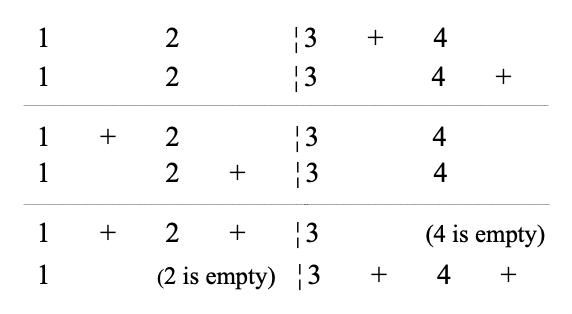
Because of where the stresses accumulate in the lines, the question of the flow and relationship between the lines solves itself: some lines hold back the movement to the next line, even leaving a pause, while other lines are fully charged near the end of the line and ready to go ahead. We simply need to have sufficient awareness of the dynamics of this formative structure and put in the time necessary for patient exploration of the myriad possibilities.
(Here is the chart with some description:
Pentameter,Shakespeare,Key,091524,KRH,pdf.)
Here is the Table of Contents for the report:
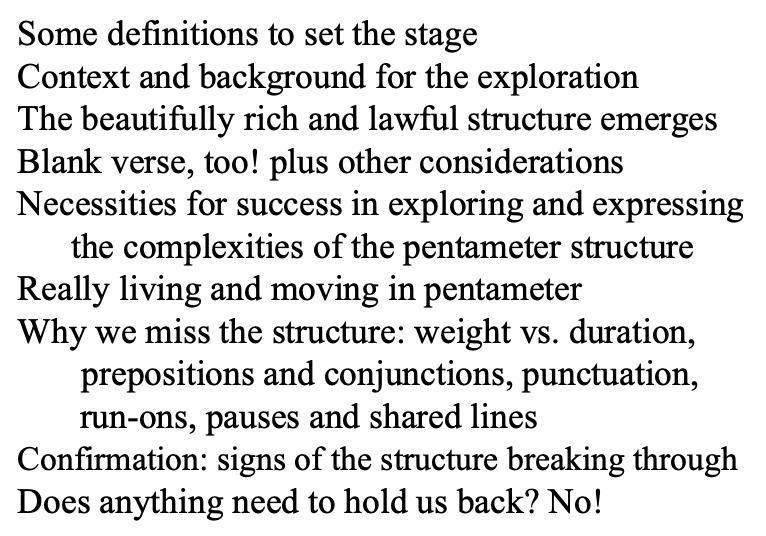
Many excerpts from Shakespeare’s plays are explored in the report. (If you hover over the character names at the head of the sections, “Why We Miss the Structure” and “Confirmation,” you will find that they are clickable; but I think it is really helpful to first take them up in context of the discussions before and after each.)
Four excerpts are specially-prepared as companion documents to the report. These are in order to facilitate further first hand exploration. Each is presented in three versions: plain, then with markings for the word-rhythms and for the 5-stress-4-beat-1-breath structure of the lines, and then markings are added for the sounds – alliteration and assonance, or for pronunciation. The markings are just suggestions based on what I have come to so far. Here are these four:
– Prologue, “O for a Muse of fire,” Henry V
– Romeo and Juliet, “But soft,” Romeo and Juliet
– Queen Gertrude, “There is a willow,” Hamlet
– King Leontes, “Inch thick,” The Winter’s Tale
The report (30 pages; with clickable Contents entries): Pentameter,Shakespeare’sPaces,Report,102624,KRH,pdf
The four excerpts:
Pentameter,Shakespeare,FourExcerpts,091524,KRH,pdf
☆ We Can Conduct Our Speaking to Rehearse the Blank Verse
When well-learned, this technique brings alive and clear the relationships between the five stresses and the four beats within the flow of the lines! Here is my description of this from the pentameter report, p. 28:
“As in conducting music, we can (if right-handed, and if left-handed do mirror image) make a sort of anchor shape in the air, with a downward stroke, a stroke leftward, a stroke rightward and a stroke left-and-upward back to the starting point: 1 2 3 4. This is the pulse, the set of four beats over the course of one unit of breath. We can then express clearly the 4/4 flow of the lines while reciting them. Then, beginning with the conducting hand held loosely closed, thumb-side up, we can mark the stresses as they occur in relation to this pulse by extending our fingers in succession one by one: pinky finger, ring finger, middle finger, pointer and then thumb. As revealed in the discussions in the report, some beats might be found to be empty, with no stressed syllable falling on them.”
◇ ◇ ◇
The Deeper Rhythmic Reality of the Harmonious 4-Beat Structure in Verse: We Unconsciously Track It in Verse
From Poetry and the Art of Speech, GA 281, March 29, 1923 lecture, “The Interaction of Breathing and BloodCirculation” (lecture excerpt: Syllables,Meter,RSteiner,091424,KRH,pdf)
“Every poetic act, every forming act of poetry ultimately rests on this ratio between breathing, as inwardly experienced, and the inner experience of the circulation of the blood. Subconsciously our breath counts the pulse-beats; and subconsciously the pulse-beats count the breaths dividing and combining, combining and dividing to mark out the meter and the syllable-quantities. … The configuration of syllables may be quite irregular, but in poetry they stand in a certain ratio to one another, essentially similar to that between breathing and circulation.”
For instance, hexameter walks in eight beats per line which fall into two sets of four beats. Each half carries three stressed syllables or “verse-feet,” leaving an empty beat, a caesura. Rudolf Steiner explained that in hexameter, “… we can see how the first three verse-feet and the caesura stand in a mutual ratio of four to one. The hexameter repeats this ratio of blood-circulation to breathing a second time. MAN* receives the spiritual into his own inner processes and inner activities when he creates poetry out of what he is at every moment of his earthly life: a product of breathing and blood-circulation. He articulates this artistically through the syllables in quantity and meter.”
*(‘Man’ and ‘he’ include all human beings without regard to gender.)
… “And we approach intensification and relaxation, tension and release, in a properly artistic way when we allow fewer or more syllables to the unit of breath. And these will then balance each other out in accordance with their inherent natural proportions. In other words, we must adjust the timing of the verse in the right way.”
Goethe Rehearsed his Verse Dramas Using a Baton.
Also from Poetry and the Art of Speech, GA 281, July 30, 1923 lecture, “Speech-Formation and Poetic Form” (lecture excerpt: PoeticFlow,RSteiner,100224,KRH,pdf.
“Over the last decades recitation and declamation have been steered more and more into a predilection for endowing with form the meaning-content of the words. A stress on the word-for-word content has become increasingly conspicuous. Our times have little understanding for such a treatment of the spoken word as was characteristic of Goethe, who used to rehearse the actors in his plays with special regard for the formation of speech, standing in front of them like a musical conductor with his baton. The speech-formation, the element of form that underlies the word-for-word content – it is really this which inspires the true poet as an artist.”
◇ ◇ ◇
Plumbing the Depths of Sound-Creation
At many times in his Speech and Drama lectures (GA 282), Rudolf Steiner demonstrated how the actor must begin the cultivation of their art with the speech sounds – really entering into the ‘gesture’ of each sound. In his July 20, 1924 News-Sheet report on the Eurythmy as Visible Speech lectures, he said that “whoever wishes to do eurythmy must have penetrated into the being of speech-formation … must, before all, have approached the mysteries of sound-creation.” Naturally, this must apply to actors and dramatists, too! (This report is usually found at the opening of the published lectures, GA 279).
The Actor’s Two Tasks: Character Delineation and Discernment of the “Sound-Feeling” of the Role
Near the opening of Lecture 13 of the Speech and Drama cycle, Rudolf Steiner said:
“[T]he written play is for the actor what the score is for the musician…. [T]he written text is like a musical score. From the text the actor has to re-create the poem in their performance on the stage, even as the musician re-creates the music from the score. For the score is a kind of zero-point between composer and performer; there they meet. It should be the same with the text of the drama. But in order to attain their goal, the actor will have to prepare themself in two directions.”
“The first thing needed is that the characters in the play are thoroughly understood … no part can be rehearsed except in conjunction with the other parts …[and] brought into right relation with one another.”

And together with this the second thing is, that through the actor’s developed sensitivity to the speech sounds, they are able to discern the vowel and consonant sounds in the lines that characterize the role!* – no doubt in really well-written scripts, such as those of Shakespeare, not in all plays. These “sound feelings” then infuse the actor’s speaking of all of the character’s lines.* Many of the lectures delve into the speech sounds and will be a great help to anyone who takes them up.!
*(This is similar to my efforts to fathom and express the sound-moods of poems, as I described in my article, “Etheric Bodies are Moving to the Speech Sound Etudes.” EthericBodiesMoving,’16,KRH,091624,pdf
Also see Lecture 15 (3rd page, plus halfway in), regarding how the spoken forming of the sounds and lines must come as easily to an actor as a pianist’s hands, which are able to move on their own when performing, thus allowing the pianist to be fully free in their expression of the piece.
I also want to say that the spoken soundscape of the lines is the ‘sound-garment’ of the particular character; and this has been my experience with every speech or dialogue from Shakespeare that I have worked on. To this sounding of the text, Rudolf Steiner said that gesture needs to be brought: “in gesture the force, the dynamic of the human being themself is present” on stage (Lecture 2, a little over halfway in).
In this Speech and Drama cycle, Rudolf Steiner gave a great deal of attention to the lost art of sounding the words, too. Words have declined into being merely ‘heard-through’ for their idea-meaning, the sounds themselves being irrelevant (see Lectures 6 and 8). And he pointed out that “if we would become true ‘formers of the word,’ we must never forget that the Word was ‘in the beginning’” (Lecture 18, a bit over halfway in).
◇ ◇ ◇ ◇ ◇

SUPPORT FOR THE WORK
Inner Activity is Essential for Foundational Work With the Word in Movement
As I described in the Prologue and in “Part Three: Inner Support for the Work” of the report, The Speech Sound Etudes: Feeling the Gesture and Finding the Figures,* success in this work with the speech sounds – and also in work with the tonal scale in music – rests upon several factors. *SpeechSoundEtudesReport,102624,KRH,pdf
For me, the first factor is the determination to actually know the contents of my experiences, not to just ‘follow my feeling’ or proceed on blind faith. In eurythmy we need to become ever more fully conscious of what we experience and do!
What does this mean? – or rather, what do I believe this means?
I have found that it is a huge mistake to believe that feeling-perceptions by themselves confer knowledge. Yet this view is commonly proclaimed and enforced in eurythmy schools: “FEEL! Don’t think! Get rid of your head!” My experience is that this orientation not only disturbs the work: it can lead to a mode of exchange between teachers and adult students that is not desired (see the plea that the forty-five third-year eurythmy program students made – they longer wanted to follow imitatively on blind faith); and the nature of the relationship might even become unhealthy.
Our feelings are merely experience; and experiencing something is only one half of what is needed in order to know the matter at hand in the experience. The other half is supplied by our thinking. It is thinking which takes action to grasp the concept which belongs to the percept. Feeling does not do this. It is percept plus concept which results in knowledge. Thinking is what makes sense of our otherwise undifferentiated mass of perceptions. The percept alone is incomplete – it needs its completion through the concept. And the concept alone, without the experience to which it relates, is mere abstraction – it needs its completion in the percept (assuming that it is not pure abstraction, relevant to nothing).
Rudolf Steiner’s writings in the field of epistemology – the branch of philosophy which concerns itself with how we know anything at all – were breakthroughs in regard to the true role of thinking in human knowledge-seeking activity (‘anthroposophy’). A Theory of Knowledge (GA 2) and The Philosophy of Spiritual Activity (GA 4), were my gateways into studying the works of Rudolf Steiner. And it is in these books that I first began to understand what I explained here above. There are no limits to what we as human beings can know!
Three articles might be a help in the development of full, differentiated knowing while seeking to deepen our feeling-perceptions as we work with speech, poetry, music and eurythmy movement.
The first article here might help to clarify what is needed to prevent an abnormal development toward the higher cognition which is to come through the heart center, when awakened. Much is said about ‘opening the heart center’ in eurythmy. But in his writings – see Knowledge of Higher Worlds and Its Attainment (GA 10) and Chapter 5 of Occult Science (GA 13) – Rudolf Steiner warned against taking a direct approach to the heart center without due inner preparation through self-training – self-training which does in fact involve thinking!
And the third article here concerns the transformation of the naive approach to artistic activity into what Rudolf Steiner called the ‘critical’ approach, one which involves actual knowledge of what is done artistically:
“What is Heart-Thinking?”
HeartThinking,091624,KRH,pdf
“Taking the Thinking Exercise in Earnest”
Thinking,MoralEx,’24,KRH,091624,pdf
“Eurythmy as a Critical Art: What This Means for Its Future” EurythmyAsCriticalArt,’16,KRH,100524,pdf

To me, the second factor upon which success rests is the preparatory work in eurythmy: practicing the art of walking, working with the rod exercises, jumping the Agrippa positions and working with color in movement (as described in the Speech Sound Etudes report). In addition, I have found that beginning practice sessions by speaking The Eurythmy Meditation aloud and taking it up inwardly as I work is essential. I am then ever-reminded that the gesture-expression comes from within my direct experiences of the elements of poetic speech and of music. EurythmyMeditation,RSteiner,092924,pdf
The Eurythmy Meditation
I seek within
The working of creative forces,
The living of creative powers.
It tells me
Of earth’s might of weight
Through the word of my feet,
It tells me
Of air’s forces of form
Through the singing of my hands,
It tells me
Of heaven’s power of light
Through the sensing of my head,
How the world in MAN [the human being] Speaks, sings, senses.
– Rudolf Steiner
Three of my articles foster the preparatory work of walking, rod exercises and the Agrippa jumping (see the positions in the section on Music and Eurythmy as Visible Music here above). These tasks help us hone our sense for how the experience and the technique of expression are one and the same (see the panel on the Home page about how experience governs the technique). “If one first realizes the experience, the experience becomes gesture” (Rudolf Steiner Lect. 2 of Eurythmy as Visible Singing, 3 pages in):
“ ‘The Word of My Feet’: The Three Parts of Walking”
“The Seven Rod Exercises: Honing the Agility of our Conscious Awareness”
“The Agrippa von Nettesheim Positions: Rudolf Steiner Told Lory to Jump!”
And the third factor involves working directly with sound-creation. This means speaking, singing and playing music. These are doorways into beginning to be able to bear witness to the Word, the Logos, as it forms our speaking of words and verse and forms our singing of melodies with our voice. My life-long experience with music has been a tremendous help – and significantly so also in working with Shakespeare’s Blank verse pentameter! Along with Part IV of the Singing and Jumping report, here are eight articles that elaborate on aspects of this work:
“Beginning With B in Light of Goethe’s Sensible-Supersensible Process”
“Imitation and Mental Imagery in Eurythmy: a Century-Long Detour” (This article discusses imitation and the alternative to it, of working out of the sounds themselves, describing how that can be done.)
VowelsUnison,Whitsun,’18,KRH,100524,pdf
“Speaking Visibly in Genuine Rhythm”
“Etheric Bodies are Moving to the Speech Sound Etudes”
“The Scale Degree Intervals Give Rise to Our Tonal Music Gebilde”
“Fixed Do and Movable Do in Our Eurythmy: Does It Matter?” (this is the first part of the text which became Part III of the Singing and Jumping report.)
Rudolf Steiner’s lectures on Poetry and the Art of Speech are also a wonderful help. Here are the two small documents of excerpts from them, which I have prepared:
PoeticFlow,RSteiner,100224,KRH,pdf
and
Syllables,Meter,RSteiner,091424,KRH,pdf
◇ ◇ ◇ ◇ ◇

REFERENCES
Master list of all of the references that are cited in the writings:
◇ ◇ ◇
Kate’s Publications
to March 2025
FULL LIST (without links)
Three Reports:
☆ Note: if you hover over the items in the Contents table within each of the reports, you will find that they are clickable, to go directly to the sections.
The blank pages are there in the report so that the pagination comes out correctly if the documents are printed two-sided.
The Speech Sound Etudes: Feeling the Gestures and Finding the Figures, posted at the EANA website, Michaelmas 2014, 20 pages (also available as a booklet). SpeechSoundEtudesReport,102624,KRH,pdf
Singing and Jumping Opens the Way to a Vital Music Eurythmy Foundation (in progress, PART II is yet to come):
⎻ “PART I, The Archetypal Scale and Its Disappearance – a Memoir” (first half, remainder to come), with Preface, Basics and Prologue, posted at the EANA website, artistic category, December 2019. I,SingJump,1stHalf,Memoir,101824,KRH,pdf
Part I pieces: J.S. Bach, Chorale, BWV 367, and Jean Marie Leclair, Sarabande in A major:
I,Bach,Chorale367,071023,Plain,pdf
I,Bach,Chorale367,Annotated,091524,KRH,pdf
I,Leclair,Sarabande,070923,plain,pdf
I,Leclair,Sarabande,Annotated,091524,KRH,pdf
⎻ “PART III: Fixed Do and Movable Do in Our Eurythmy – Does it Matter?” (first half, remainder to come), March 2022, revised August 2023. III,SingJump,1stHalf,Fixed-MovableDo+Scores,101824,KRH,pdf
⎻ “PART IV: The Singing and Jumping Exercises – Real Sound-Experiences Lead to Real Gestures,” March 2022. IV,SingJump,Exercises,103024,KRH,pdf
Revealing the Music of Pentameter: Putting Shakespeare Through His Paces, EANA.org, artistic category, 2019.
☆ Note: if you hover over the character names listed at the head of the sections on “Why We Miss the Structure” and “Confirmation,” you will find they are clickable, to go directly to those explorations.
The report:
Pentameter,Shakespeare’sPaces,Report,102624,KRH,pdf
The set of four excerpts as companion document: Pentameter,Shakespeare,FourExcerpts,091524,KRH,pdf
Booklets
Contact Kate for copies or inquire at the Rudolf Steiner Library in Hudson NY, or the Turose Gift Shop in Ghent NY.
The Speech Sound Etudes: Feeling the Gestures and Finding the Figures (posted at the EANA website, 2014).
The Speech Sound Etudes, Volume I: Revelations of the Logos; Poetic Miniatures for Sounding our Language, 2016.
Slim Edition of Volume 1 – the speech sound etude studies without the intensive texts.
A Quartet of Articles – the first four of Kate’s articles.
A Quintet of Articles Concerning the Gesture-Impulses of the Speech Sounds (booklet yet to come).
A Quintet of Articles on Music Eurythmy (booklet yet to come).
Awakening our Empfindung-Sensibilities to Movable Do and the 1915 Angle-Gestures – a tutorial from the Eurythmy Festival workshop given by Kate in Chestnut Ridge NY, August 2023.
Articles for the Eurythmy Association of North America (EANA) Newsletter
In order of publication:
“ ‘The Word of My Feet’: The Three Parts of Walking,” spring 2015. WordOfMyFeet,’15,KRH,091624,pdf
“The Seven Rod Exercises: Honing the Agility of our Conscious Awareness,” autumn 2015.
7RodExercises,’15,KRH,091624,pdf
“Etheric Bodies are Moving to the Speech Sound Etudes,” spring 2016. EthericBodiesMoving,’16,KRH,091624,pdf
“Eurythmy as a Critical Art: What This Means for Its Future,” autumn 2016. EurythmyAsCriticalArt,’16,KRH,100524,pdf
“Eurythmy as an Art that Makes Visible the Inaudible, Invisible and Unsounded Contents of Poetic Speech and Wordless Singing,” spring 2017.
EurythmyIs…,’17,KRH,092124,pdf
“Beginning With B in Light of Goethe’s Sensible-Supersensible Process,” autumn 2017.
BeginningB,Goethe’sProcess,’17,KRH,091624,pdf
“Finding Unison in the Vowels: The Hope and Blessing of Whitsun,” spring 2018. VowelsUnison,Whitsun,’18,KRH,100524,pdf
“The Scale Degree Intervals Give Rise to Our Tonal Music Gebilde,” spring 2019. ScaleDegreeIntervals,TonalGebilde,’19,KRH,100924,pdf
“Speaking Visibly in Genuine Rhythm,” autumn 2019.
SpeakingVisibly,GenuineRhythm,’19,KRH,091624,pdf
“The Agrippa von Nettesheim Positions: Rudolf Steiner Told Lory to Jump!” spring 2020. AgrippaJump!,’20,KRH,092524,pdf
“The Kindling Character of K,” autumn 2020.
KindlingK,’20,KRH,091624,pdf
“Fixed Do and Movable Do in Our Eurythmy: Does It Matter?” autumn 2021 (this website version is enlarged). FixedvsMovableDo,Matters,’21,KRH,101824,pdf
“The Earliest Records Show the Angle-Gestures as Movable Do,” spring 2022 (the Performing Arts Section Newsletter version is shorter).
“Imitation and Mental Imagery in Professional Eurythmy,” autumn 2022 – revised and in two parts for the Chanticleer newsletter, October and November 2023 (see below).
“My Responsibility to the Onlooker in Music Eurythmy,” autumn 2023 – revised in 2024 with new endnotes. MyResponsibilityToOnlooker,’23,KRH,101924,pdf
For the Performing Arts Section Newsletter at the Goetheanum (also in German):
“The 1915 Angle-Gestures are Movable Do,” Nr. 78, Easter 2023. (This is a drastically-shortened version of the EANA spring 2022 article.)
“My Responsibility to the Onlooker in Music Eurythmy,” Nr. 81, Michaelmas 2024. For the article in English, please see in the EANA articles list above. Here is the German, revised and with its intended title and additional endnotes:
“Meine Verantwortung gegenüber Zushauenden in der Musikeurythmy” MeineVerantwortung,Musikeurythmie,’24,KRH,101724,pdf
For Chanticleer, the newsletter of the Berkshire-Taconic Branch of the Anthroposophical Society in America:
“Imitation and Mental Imagery in Eurythmy: a Century-Long Detour,” October and November 2023. Imitation,Imagery,Detour,’22,KRH,110224,pdf
“Taking the Thinking Exercise in Earnest,” April 2024. Thinking,MoralEx,’24,KRH,091624,pdf
“The January 2025 ‘Smart’ Meter Rollout in Light of Insights on Electricity from Rudolf Steiner,” December 2024,
RSteiner on Electricity,MetersAlert2025,KRH,111624,pdf
Short Documents
☆ Note: a number of these documents have a duplicate second page. This is to facilitate two-sided printing (for landscape orientation, remember to set the printing to ‘short-edge’ flip or binding).
Keys and Charts
Short Speech Sound Markings (from the Revealing the Music of Pentameter report, p. 27):
ShortSpeechSoundKeyPentameterReportSSh1jpg
The FULL Speech Sound Markings Key (from The Speech Sound Etudes report):
SpeechSoundMarkings,091424,KRH,pdf
Pentameter, the Rhythmic-Metrical 5-Stress-4-Beat Structure, Key: Pentameter,Shakespeare,Key,091524,KRH,pdf
Fully-Chromatic Numerical Solfège Key:
NumericalSolfège,FullyChromatic,KRH,092924,pdf
The Circle of Fifths Relationships of Tonal Music:
Circle of FifthsRelationships,101724,KRH,pdf
Harmonic Markings Key:
HarmonicMarkings,091424,KRH,pdf
The Agrippa von Nettesheim Positions:
AgrippaPositionsSSh0916,jpg
Reference Documents
Contents Page for all four Parts of the report, Singing and Jumping Opens the Way to a Vital Music Eurythmy Foundation:
Sing&Jump,Contents,081824,KRH,pdf
Full Reference List: References,101924,KRH,pdf
Kate Reese Hurd’s Publications List:
PublicationsList,092124,KRH,pdf
About the Author-Composer, Kate Reese Hurd:
Author-ComposerBio,091424,pdf
Texts
“In the Beginning was the Word,” from the Gospel of St. John: InTheBeginning,John,Chapter1,Verses1-5,pdf
The Eurythmy Meditation: EurythmyMeditation,RSteiner,092924,pdf
Examples of Speech Sound Etude-Studies and a Set of Four Etudes for B:
Etude-Studies,Examples,092424,pdf
On the origin of poetry, from Rudolf Steiner:
PoeticFlow,RSteiner,100224,KRH,pdf
On syllables and meter, from Rudolf Steiner:
Syllables,Meter,RSteiner,091424,KRH,pdf
What is Eurythmy?
Eurythmy Is,091424,KRH,pdf
What is Heart-Thinking?
HeartThinking,091624,KRH,pdf
Michael Kaulkin on “The Case for Movable Do”:
Kaulkin,091424,KRH,pdf

◇ ◇ ◇ ◇ ◇ ◇ ◇
